Systematic Measurement and Evolution Situation of Coupling Coordination Level between Intensive Cultivated Land Utilization and New-Type Urbanization
Abstract
:1. Introduction
2. Index System, Model and Method
2.1. Index System
| Target Layer | Criterion Layer | Weights | Index Layer | Weights |
|---|---|---|---|---|
| Arable land collection utilization subsystem | Intensity of arable land input | 0.3414 | The average agricultural machinery input | 0.0434 |
| Fertilizer input is averaged in the ground | 0.0361 | |||
| The average agricultural electricity input is provided | 0.2355 | |||
| Land average manpower input | 0.0264 | |||
| Intensity of arable land utilization | 0.1082 | Multiple cropping index | 0.0341 | |
| Reclamation Index | 0.0255 | |||
| Irrigation index | 0.0486 | |||
| The level of arable land output | 0.1104 | Average ground yield | 0.0463 | |
| Labor average production | 0.0383 | |||
| Food yields | 0.0258 | |||
| Sustainable use of arable land | 0.1478 | Average land share of water resources | 0.0857 | |
| Arable land balance index | 0.0130 | |||
| Food security index | 0.0491 | |||
| Degree of labor intensification | 0.1021 | Arable land safety factor | 0.0539 | |
| Labor Force Index | 0.0198 | |||
| Rural population density | 0.0284 | |||
| Agricultural structure | 0.1901 | Proportion of animal husbandry | 0.0256 | |
| Proportion of forestry | 0.0618 | |||
| Proportion of agriculture | 0.0261 | |||
| Proportion of fisheries | 0.0766 | |||
| Urbanization subsystem | Economic urbanization | 0.3014 | Per capita disposable income of urban residents | 0.0794 |
| The average wage of urban workers on the job | 0.0658 | |||
| The added value of the secondary and tertiary industries accounts for the proportion of GDP | 0.0143 | |||
| General public budget revenue as a share of GDP | 0.0390 | |||
| GDP per capita | 0.0542 | |||
| Investment in fixed assets in the whole society | 0.0487 | |||
| Population urbanization | 0.1852 | Urban unemployment registration rate | 0.0341 | |
| Coverage of basic medical insurance in cities and towns | 0.0429 | |||
| Proportion of urban population | 0.0364 | |||
| Urban population density | 0.0368 | |||
| Urban basic old-age insurance coverage | 0.0350 | |||
| Land urbanization | 0.1086 | Fixed asset investment on land for construction purposes | 0.0235 | |
| Proportion of built-up areas | 0.0334 | |||
| Per capita area of urban construction land | 0.0517 | |||
| Social urbanization | 0.1830 | Number of students enrolled in institutions of higher learning | 0.0339 | |
| Number of announced cars per 10,000 people | 0.0393 | |||
| Education revenue as a share of GDP | 0.0422 | |||
| Number of beds in healthcare facilities per 1000 people | 0.0332 | |||
| Water supply penetration | 0.0209 | |||
| Gas penetration rate | 0.0135 | |||
| Ecological environment urbanization | 0.0460 | The harmless treatment rate of domestic garbage | 0.0133 | |
| Municipal sewage treatment rate | 0.0127 | |||
| Green coverage of built-up areas | 0.0200 | |||
| Innovation and R&D | 0.1758 | R&D funding intensity | 0.0601 | |
| Number of patent applications granted per 10,000 people | 0.1157 |
2.2. Models and Methods
2.2.1. Entropy Method
- (1)
- Data standardization processing is as follows:
- (2)
- Calculate the proportion of the value of the jth index in the ith year, as follows:
- (3)
- Calculate the entropy of index information, as follows:
- (4)
- Calculate the redundancy of information entropy, as follows:
- (5)
- Calculate the weight of each index , as follows:
- (6)
- Calculate the comprehensive evaluation index, as follows:
2.2.2. Coupled Coordinated Development Degree Model
2.2.3. Kernel Density Estimation
2.2.4. Theil Index Method
3. Results
3.1. Evolutionary Characteristics of the Level of Cultivated Land Intensive Use and New-Type Urbanization
| Province | Evaluation Index | In 2008 | In 2020 | Mean | Province | Evaluation Index | In 2008 | In 2020 | Mean |
|---|---|---|---|---|---|---|---|---|---|
| Beijing | CL | 0.3902 | 0.3063 | 0.2956 | Beijing | NU | 0.6973 | 0.5758 | 0.6394 |
| Tianjin | CL | 0.3311 | 0.2196 | 0.2543 | Tianjin | NU | 0.4637 | 0.3862 | 0.4271 |
| Hebei | CL | 0.3177 | 0.2136 | 0.2569 | Hebei | NU | 0.2798 | 0.3332 | 0.2789 |
| Shanxi | CL | 0.1760 | 0.1385 | 0.1543 | Shanxi | NU | 0.2542 | 0.2733 | 0.2550 |
| Inner Mongolia | CL | 0.2103 | 0.1920 | 0.1954 | Inner Mongolia | NU | 0.2245 | 0.2470 | 0.2457 |
| Liaoning | CL | 0.2656 | 0.1873 | 0.2113 | Liaoning | NU | 0.3804 | 0.2749 | 0.3193 |
| Jilin | CL | 0.2398 | 0.2027 | 0.2032 | Jilin | NU | 0.2479 | 0.2401 | 0.2350 |
| Heilongjiang | CL | 0.2240 | 0.2614 | 0.2410 | Heilongjiang | NU | 0.2509 | 0.2839 | 0.2591 |
| Shanghai | CL | 0.5774 | 0.4946 | 0.5633 | Shanghai | NU | 0.6528 | 0.4877 | 0.5612 |
| Jiangsu | CL | 0.4294 | 0.3215 | 0.3759 | Jiangsu | NU | 0.5306 | 0.5284 | 0.5224 |
| Zhejiang | CL | 0.4883 | 0.3642 | 0.3870 | Zhejiang | NU | 0.5244 | 0.4877 | 0.5018 |
| Anhui | CL | 0.3119 | 0.2478 | 0.2810 | Anhui | NU | 0.2483 | 0.3468 | 0.2826 |
| Fujian | CL | 0.5178 | 0.3970 | 0.4460 | Fujian | NU | 0.3083 | 0.3688 | 0.3184 |
| Jiangxi | CL | 0.3690 | 0.2578 | 0.3096 | Jiangxi | NU | 0.2924 | 0.3423 | 0.2970 |
| Shandong | CL | 0.3932 | 0.2752 | 0.3150 | Shandong | NU | 0.4081 | 0.4162 | 0.3994 |
| Henan | CL | 0.3643 | 0.2643 | 0.3027 | Henan | NU | 0.2940 | 0.3792 | 0.3008 |
| Hubei | CL | 0.3165 | 0.2501 | 0.2734 | Hubei | NU | 0.2673 | 0.3174 | 0.2920 |
| Hunan | CL | 0.3814 | 0.2912 | 0.3265 | Hunan | NU | 0.2569 | 0.3800 | 0.2836 |
| Guangdong | CL | 0.4941 | 0.3722 | 0.4112 | Guangdong | NU | 0.5039 | 0.5477 | 0.5053 |
| Guangxi | CL | 0.3137 | 0.2743 | 0.2838 | Guangxi | NU | 0.1886 | 0.2641 | 0.2040 |
| Hainan | CL | 0.3669 | 0.3154 | 0.3137 | Hainan | NU | 0.2124 | 0.2985 | 0.2527 |
| Chongqing | CL | 0.2546 | 0.2254 | 0.2207 | Chongqing | NU | 0.2537 | 0.2794 | 0.2959 |
| Sichuan | CL | 0.2665 | 0.2358 | 0.2320 | Sichuan | NU | 0.2659 | 0.3427 | 0.2912 |
| Guizhou | CL | 0.1859 | 0.1944 | 0.1747 | Guizhou | NU | 0.1638 | 0.2714 | 0.2119 |
| Yunnan | CL | 0.2302 | 0.1857 | 0.2016 | Yunnan | NU | 0.2243 | 0.2787 | 0.2256 |
| Shaanxi | CL | 0.1942 | 0.1987 | 0.1897 | Shaanxi | NU | 0.3261 | 0.3583 | 0.3309 |
| Gansu | CL | 0.1460 | 0.1342 | 0.1238 | Gansu | NU | 0.2120 | 0.2528 | 0.2245 |
| Qinghai | CL | 0.2305 | 0.1926 | 0.2143 | Qinghai | NU | 0.2439 | 0.2749 | 0.2511 |
| Ningxia | CL | 0.2048 | 0.1610 | 0.1731 | Ningxia | NU | 0.2356 | 0.2748 | 0.2587 |
| Xinjiang | CL | 0.2587 | 0.1938 | 0.2387 | Xinjiang | NU | 0.3280 | 0.3021 | 0.3199 |
| mean | 0.3150 | 0.2523 | mean | 0.3247 | 0.3471 | ||||
3.2. The Evolution of the Coupling and Coordination Level of Cultivated Land Intensive Use and New-Type Urbanization
3.2.1. Overall National Level
3.2.2. Regional Level
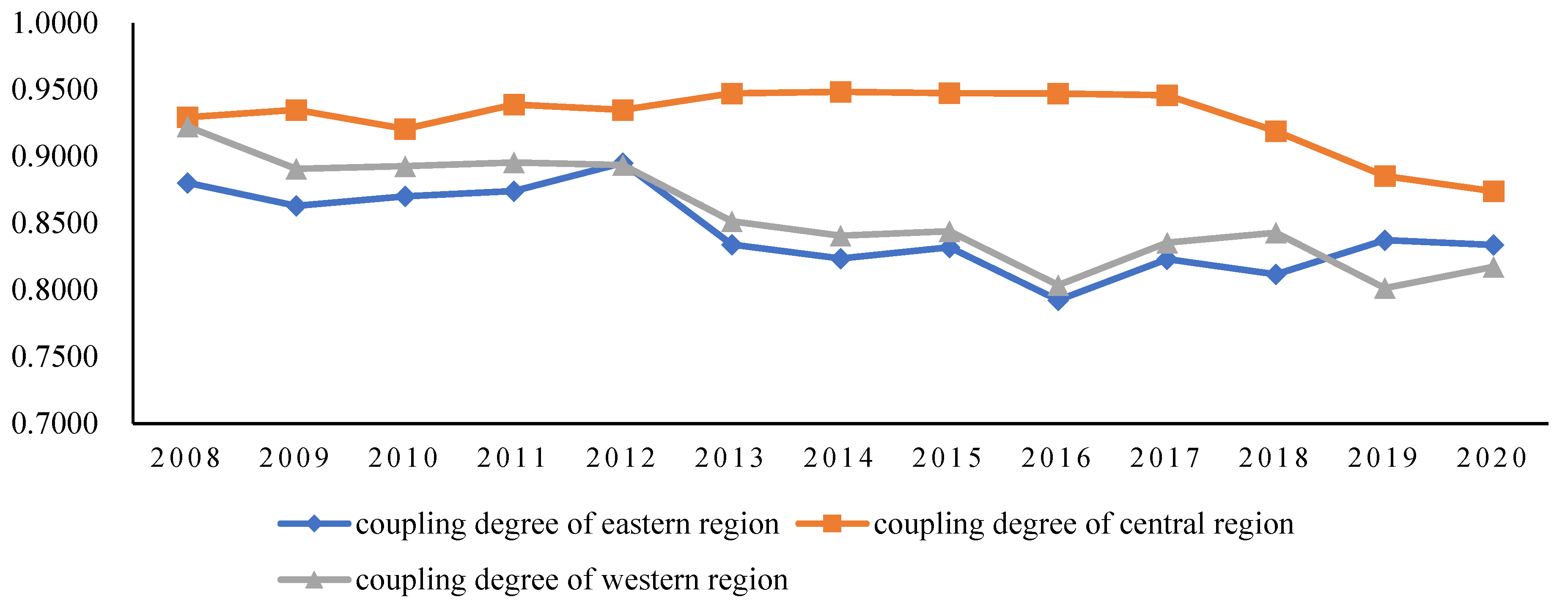
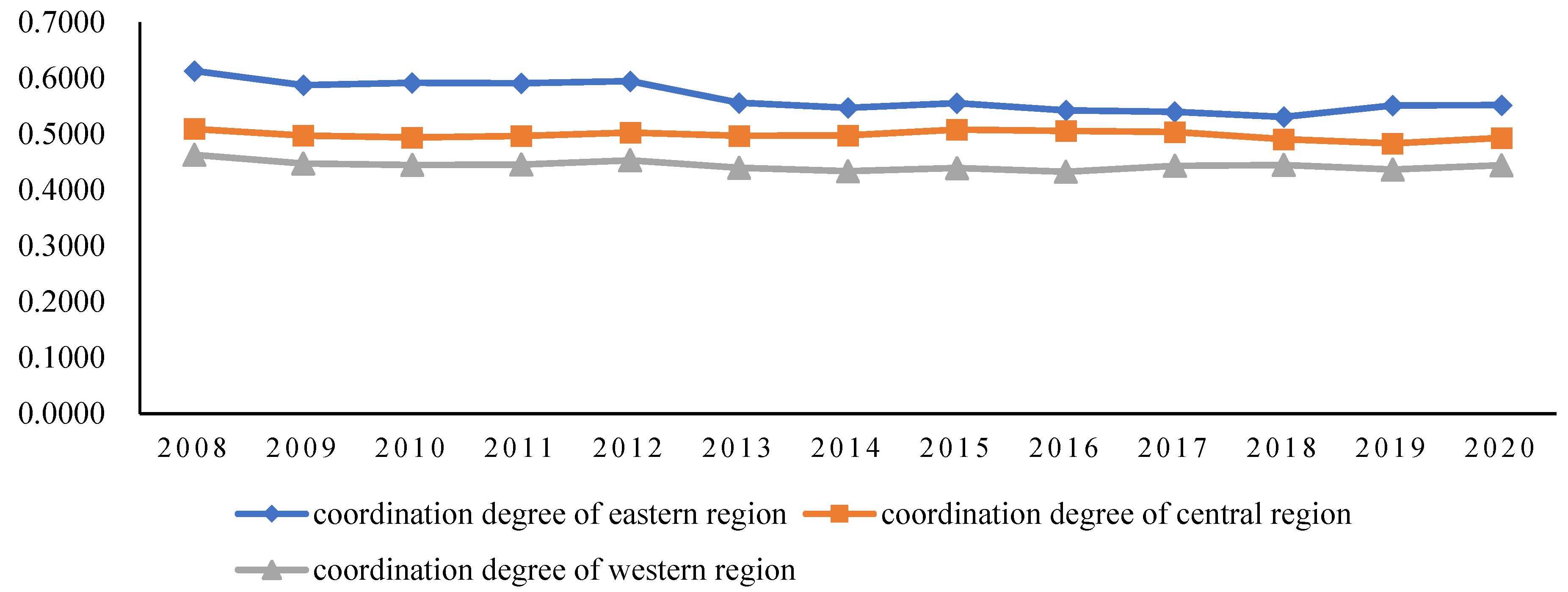
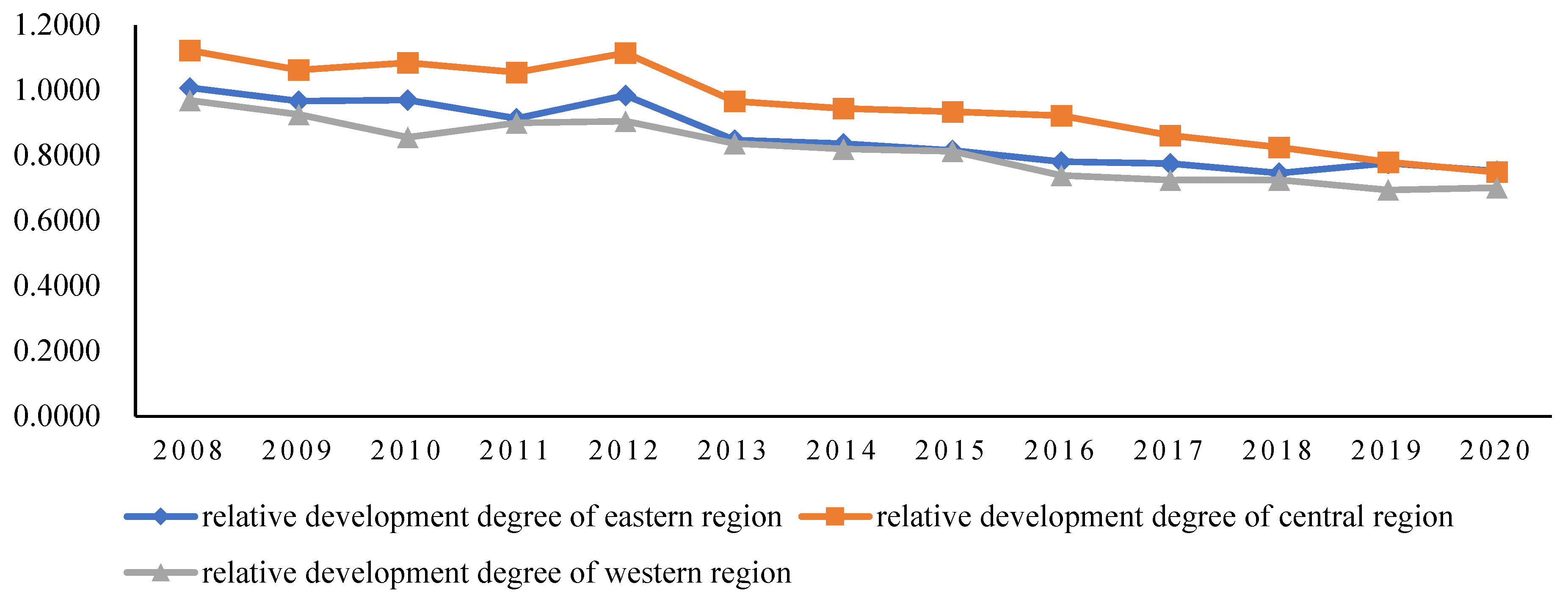
3.2.3. Provincial Level
4. Re-Examination Based on Kernel Density Estimation and Theil Index
4.1. Kernel Density Estimation
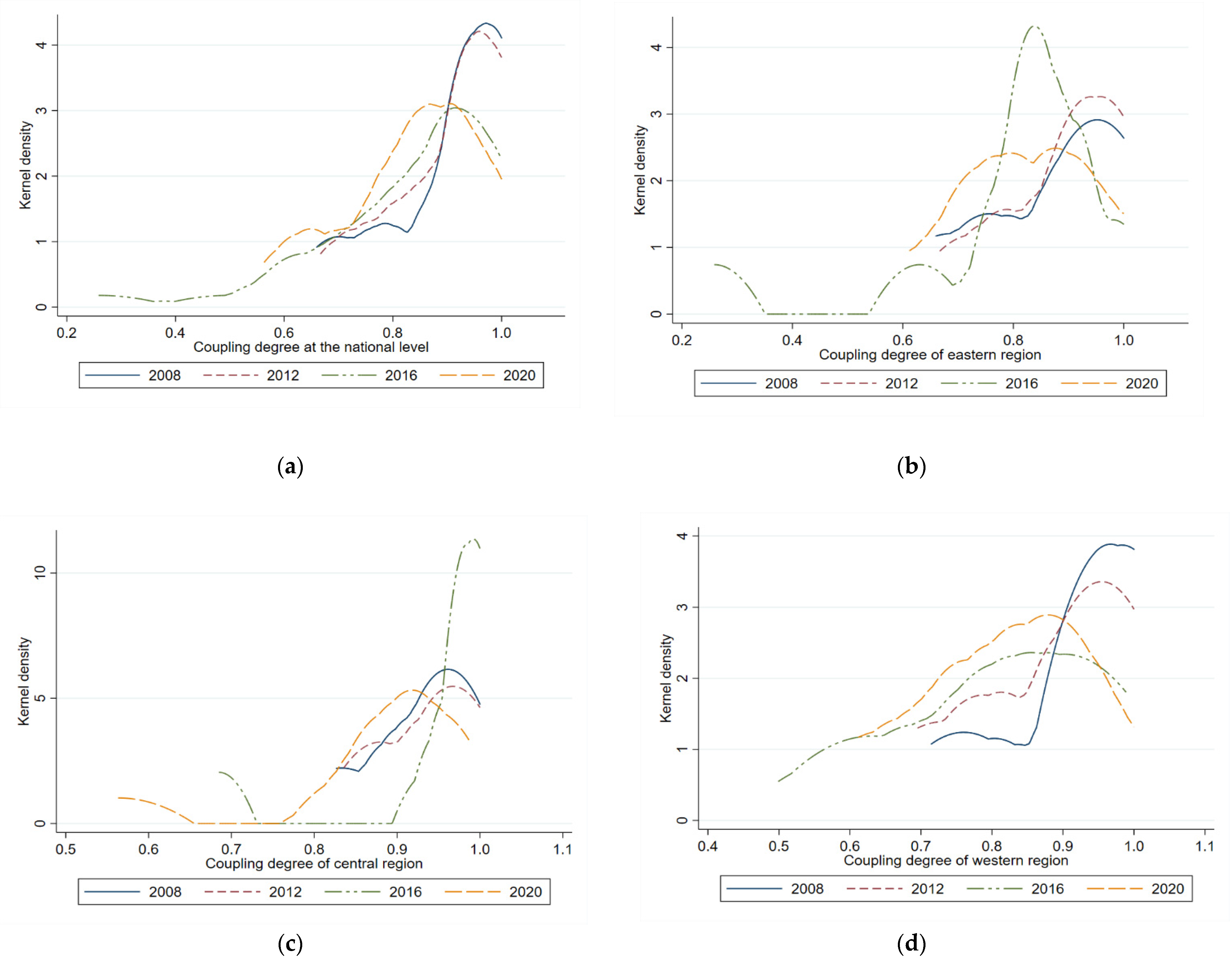

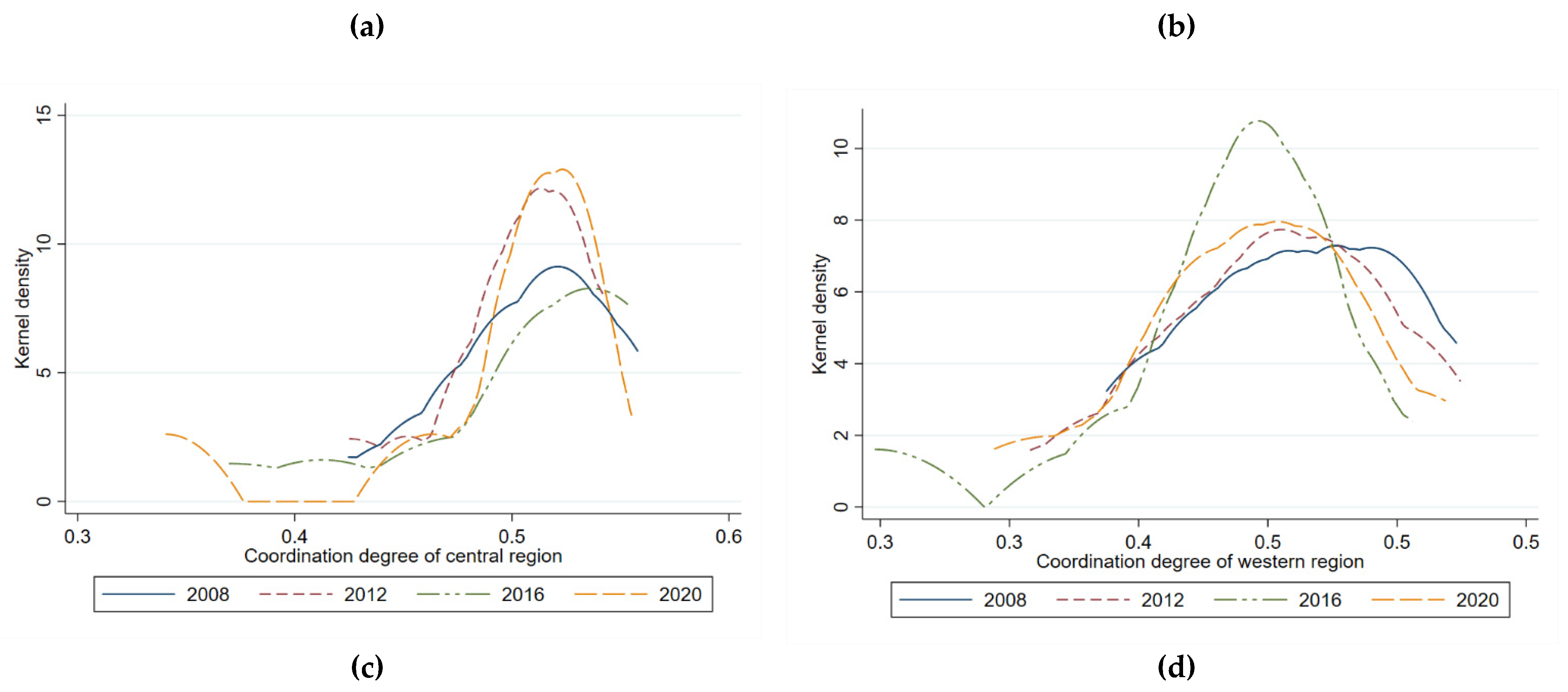

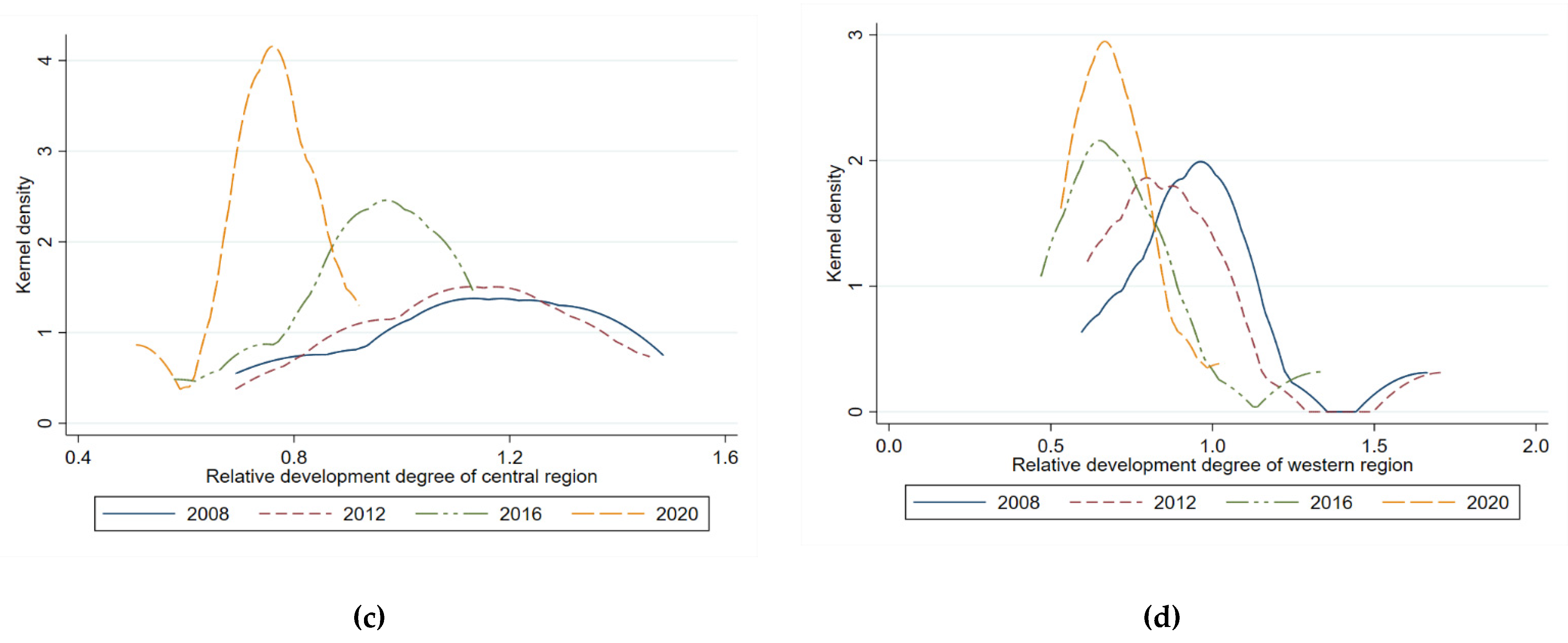
4.2. Theil Index


| Coupling Degree | Coordination Degree | Relative Development Degree | ||||||
|---|---|---|---|---|---|---|---|---|
| Year | Within the Group | Between Groups | Year | Within the Group | Between Groups | Year | Within the Group | Between Groups |
| In 2008 | 0.9599 | 0.0401 | In 2008 | 0.4832 | 0.5168 | In 2008 | 0.9575 | 0.0425 |
| In 2009 | 0.9464 | 0.0536 | In 2009 | 0.5405 | 0.4595 | In 2009 | 0.9679 | 0.0321 |
| In 2010 | 0.9717 | 0.0283 | In 2010 | 0.5108 | 0.4892 | In 2010 | 0.9036 | 0.0964 |
| In 2011 | 0.9561 | 0.0439 | In 2011 | 0.4888 | 0.5112 | In 2011 | 0.9450 | 0.0550 |
| In 2012 | 0.9714 | 0.0286 | In 2012 | 0.4783 | 0.5217 | In 2012 | 0.9190 | 0.0810 |
| In 2013 | 0.8879 | 0.1121 | In 2013 | 0.6133 | 0.3867 | In 2013 | 0.9585 | 0.0415 |
| In 2014 | 0.8934 | 0.1066 | In 2014 | 0.6590 | 0.3410 | In 2014 | 0.9619 | 0.0381 |
| In 2015 | 0.9130 | 0.0870 | In 2015 | 0.6664 | 0.3336 | In 2015 | 0.9548 | 0.0452 |
| In 2016 | 0.8716 | 0.1284 | In 2016 | 0.7165 | 0.2835 | In 2016 | 0.9114 | 0.0886 |
| In 2017 | 0.9200 | 0.0800 | In 2017 | 0.7778 | 0.2222 | In 2017 | 0.9214 | 0.0786 |
| In 2018 | 0.9375 | 0.0625 | In 2018 | 0.7962 | 0.2038 | In 2018 | 0.9480 | 0.0520 |
| In 2019 | 0.9483 | 0.0517 | In 2019 | 0.6820 | 0.3180 | In 2019 | 0.9480 | 0.0520 |
| In 2020 | 0.9685 | 0.0315 | In 2020 | 0.6542 | 0.3458 | In 2020 | 0.9749 | 0.0251 |
| Mean | 0.9343 | 0.0657 | Mean | 0.6205 | 0.3795 | Mean | 0.9440 | 0.0560 |
5. Conclusions, Implications and Prospects
5.1. Conclusions
5.2. Implications
5.3. Prospects
Author Contributions
Funding
Institutional Review Board Statement
Informed Consent Statement
Data Availability Statement
Conflicts of Interest
References
- Wang, X.; Shen, X.; Wang, Z.; Liu, X. Dynamic evaluation of farmland intensive use in 2010–2016 in China. China Popul. Resour. Environ. 2019, 29, 58–67. [Google Scholar]
- Fan, H. Evaluation of Cultivated Land Intensive Use in Henan Province Based on the Competition-cooperation Law. J. Xinyang Norm. Univ. (Nat. Sci. Ed.) 2019, 32, 572–578. [Google Scholar]
- Yue, R.; Lei, G.; Ding, X.; Yin, J.; Qu, X. Prediction and Obstacle Factors Diagnosis of Intensive Use of Cultivated Land in Harbin city. Chin. J. Agric. Resour. Reg. Plan. 2017, 38, 59–66. [Google Scholar]
- Zhou, Y.; Liu, J. Spatial-Temporal Difference of Farmland Intensive Use in China—A Panel-data Study Based on Projection Pursuit Model. Chin. J. Agric. Resour. Reg. Plan. 2015, 36, 22–30. [Google Scholar]
- Zhao, W.; Huang, J.; Fan, L.; Zhang, Z. On the Change in Intensive Use Level of Cultivated Land in Chongqing during 2006–2010. J. Southwest Univ. (Nat. Sci. Ed.) 2013, 35, 115–120. [Google Scholar]
- Yang, Y.; Yao, Y.; Hao, S. Spatial—Temporal Variations and Influencing Factors of Intensified Cultivated Land Use Level in Guizhou Province Based on GWR Model. Res. Soil Water Conserv. 2022, 29, 326–332, 338. [Google Scholar]
- Zhang, L.; Li, Z. Changes and Driving Factors of Cultivated Land Use Intensity in Yellow River Delta. Chin. J. Agric. Resour. Reg. Plan. 2022, 43, 124–134. [Google Scholar]
- Zhang, R.; Lu, J. Multiscale spatiotemporal characteristics and influencing factors of intensive cultivated land use in Yangtze River Economic Belt. Trans. Chin. Soc. Agric. Eng. 2019, 35, 271–278. [Google Scholar]
- Xing, L.; Fang, B.; Xiang, M. Temporal and Spatial Variation of Cultivated Land Intensive Use Level and Its Influencing Factors in Jiangsu Province Based on GWR Model. Resour. Environ. Yangtze Basin 2019, 28, 376–386. [Google Scholar]
- Liu, J.; Hou, X.; Wang, Z.; Xia, C.; Meng, Q. Spatial Correlation Characteristics of Fragmentation and Intensive Use Levels of Cultivated Land in Hubei Province. China Land Sci. 2017, 31, 51–59. [Google Scholar]
- Peng, W.; Lv, X. Coupling Relationship between Scale Management and Intensive Use of Cultivated Land from the Perspective of Farmer Household. Geogr. Geo-Inf. Sci. 2019, 35, 91–97. [Google Scholar]
- Wang, J.; Xue, D.; Ma, B.; Song, Y. Study on spatial-temporal coupling relationship of cultivated land intensive use and agricultural carbon emission in five provinces of Northwestern China. Environ. Sci. Technol. 2019, 42, 211–217. [Google Scholar]
- Sun, Y.; Su, X.; Xu, H. Correlation between levels of cultivated land intensive use and carbon emission efficiency in Hebei Province. Trans. Chin. Soc. Agric. Eng. 2016, 32, 258–267. [Google Scholar]
- Shi, Y.; Zhai, G.; Lu, Y.; Liu, H.; Zhou, S. Measurement and Dynamic Analysis of the Coordination Level of Urbanization Scale and Urbanization Quality in China. Areal Res. Dev. 2021, 40, 12–18. [Google Scholar]
- Tang, J.; He, Q.; Liu, Y. Spatiotemporal dislocation and influencing factors of urbanization quality and scale in Yangtze River Delta urban agglomeration. J. Cent. China Norm. Univ. (Nat. Sci.) 2022, 56, 703–716. [Google Scholar]
- Zhao, N. Measurement and evaluation of the development quality of new urbanization. Stat. Decis. 2020, 36, 57–60. [Google Scholar]
- Ding, H. Measurement of comprehensive development level of new urbanization in coastal areas. Stat. Decis. 2019, 35, 50–53. [Google Scholar]
- Lu, C.; Wen, F.; Yuan, X.; Qin, Y. Research on Risk Identification of Urbanization Based on the Entropy Method in Henan Province. Chin. J. Agric. Resour. Reg. Plan. 2018, 39, 142–147. [Google Scholar]
- Xiong, X.; Xu, Z. Research on Level and Mechanical Machine under the Guidance of New Urbanization. J. Quant. Tech. Econ. 2018, 35, 44–63. [Google Scholar]
- Yang, Y.; Huang, C.; He, C.; Huang, Q. The Spatiotemporal Dynamics of New-Type Urbanization Comprehensive Level in Shandong Peninsula Urban Agglomeration. Econ. Geogr. 2017, 37, 77–85. [Google Scholar]
- Xiao, Z.; Ning, Z.; Zhang, J. Research on the Evaluation of New Urbanization Degree Based on the Perspective of Urban Agglomeration. Econ. Probl. 2017, 7, 92–98. [Google Scholar]
- Wang, J.; Li, J. The Evaluation and Analysis on the Development of New Urbanization: Based on the Coordinated Development for the Beijing–Tianjin–Hebei Region. Popul. Econ. 2017, 6, 58–70. [Google Scholar]
- Du, J.; Zhang, X. The Spatial-Temporal Evolution Characteristics of Population Urbanization Quality Based on Two-factor Theory. Henan Sci. 2021, 39, 1663–1672. [Google Scholar]
- Zhao, T.; Liu, Z.; Guo, S.; Li, K. Research on the spatial-temporal characteristics and influencing factors of urbanization in the Yellow River basin. J. Shaanxi Univ. Technol. (Nat. Sci. Ed.) 2021, 37, 82–89. [Google Scholar]
- Guo, X.; Li, J.; Du, X. The Coordinated Development of New Urbanization and Rural Revitalization: Based on the Micro Investigation of Heilongjiang Province. Commer. Res. 2022, 2, 49–55. [Google Scholar]
- Xu, X.; Wang, Y. Measurement of coordination level between new urbanization and rural revitalization in Gansu Province and its influencing factors. J. Desert Res. 2022, 42, 1–13. [Google Scholar]
- Xu, W.; Li, L.; Zhou, J.; Liu, C. The dynamic evolution and its driving mechanism of coordination of rural rejuvenation and new urbanization. J. Nat. Resour. 2020, 35, 2044–2062. [Google Scholar] [CrossRef]
- Zhang, J. Analysis on the coordination of new urban and rural governance in Henan. Chin. J. Agric. Resour. Reg. Plan. 2020, 41, 204–211. [Google Scholar]
- Xiong, X.; Yu, X.; Wang, Y. Interaction between New Urbanization and Industrial Structure of Double-City Economic Circle in Chengdu and Chongqing. Reform Econ. Syst. 2022, 2, 42–49. [Google Scholar]
- Liu, Y.; Dong, W.; Wang, N.; Ding, T.; Dong, Y. Analysis on the Coupling Coordination Relationship between Characteristic Culture City and New Urbanization: A Case Study of Five Cities in China. Urban Dev. Stud. 2021, 28, 27–36. [Google Scholar]
- Zhu, Y.; Wang, Z.; Luo, J.; Cui, J. Coupling and coordinated development of new urbanization and food security in main agricultural production regions in central China: A case study of Henan Province. Sci. Geogr. Sin. 2021, 41, 1947–1958. [Google Scholar]
- Zeng, J.; Qian, Y.; Zhu, L.; Guang, X.; Zhang, Y. Coordinated Development and Evolution of Multidimensional Rail Transit and New Urbanization in Western China. Econ. Geogr. 2021, 41, 77–86. [Google Scholar]
- Zhao, J.; Liu, Y.; Zhu, Y.; Qin, S.; Wang, Y.; Miao, C. Spatiotemporal differentiation and influencing factors of the coupling and coordinated development of new urbanization and ecological environment in the Yellow River Basin. Resour. Sci. 2020, 42, 159–171. [Google Scholar] [CrossRef]
- Zhang, N. Research on interactive relationship between new urbanization and agricultural industry upgrade in Tangshan city. Chin. J. Agric. Resour. Reg. Plan. 2019, 40, 282–287. [Google Scholar]
- Wei, M.; Hu, Z. An empirical research on the coordinated development between new urbanization and industrial structure evolution in Hunan. Sci. Res. Manag. 2019, 40, 67–84. [Google Scholar]
- Yang, X.; Zhang, D. Study of Coupling Coordination between Tourism Economy and the New Urbanization: Taking Lanzhou City as an Example. Ecol. Econ. 2018, 34, 112–117. [Google Scholar]
- Li, L.; Xu, L.; Dong, J. Spatial-Temporal Coupling Coordination Between the New Urbanization and Construction Land Use Level—Taking Changsha—Zhuzhou—Xiangtan City Group as an Example. Res. Soil Water Conserv. 2017, 24, 314–319, 346. [Google Scholar]
- Bao, J.; Lv, J. Temporal and Spatial Evolution of Coordinated Development between New Urbanization and Intensive Use of Cultivated Land in Gansu Province. Nat. Resour. Inf. 2022, 2, 1–9. [Google Scholar]
- Li, Z.; Jiang, B.; Zhang, Y.; Zhao, Y. Evaluation and Prediction of Coordination between New Urbanization and Intensive Use of Cultivated Land in Three Northeastern Provinces of China. Res. Soil Water Conserv. 2021, 28, 260–267. [Google Scholar]
- Li, D.; Wu, B.; Wang, X.; Mei, X. Research on spatiotemporal differentiation characteristic of the coupling and coordinated of new urbanization and cultivated land use in the Heilongjiang province. Chin. J. Agric. Resour. Reg. Plan. 2022, 43, 143–155. [Google Scholar]
- Zhu, R.; Chen, S. The Grey correlation and coupling analysis of intensive use of farmland and new urbanization: A case study of Fujian Province. Res. Agric. Mod. 2021, 42, 600–609. [Google Scholar]
- Wubuli, J.; Maimaitiming, A.; Xue, D. Coupling and coordinated development of urbanization and intensive utilization of cultivated land: A case study in Aksu city, Xinjiang. Arid. Zone Res. 2019, 36, 1333–1343. [Google Scholar]
- Deng, C.; Shi, J. Study on the Coupling Degree of Intensive Use of Cultivated Land and Urbanization: A Case Study of Xiangxi Prefecture. Hubei Agric. Sci. 2018, 57, 80–85, 89. [Google Scholar]
- Cao, C. Research on the Coupled and Coordinated Development of Intensive Use of Cultivated Land and New Urbanization—A Case study in Jiangsu province. Chin. J. Agric. Resour. Reg. Plan. 2018, 39, 67–73. [Google Scholar]
- Ye, Q.; Cao, J. Dynamic cointegration analysis of urbanization and intensive use of cultivated land in Jianghan Plain. Stat. Decis. 2017, 15, 108–111. [Google Scholar]
- Lu, Y.; Wang, H.; Hu, Y.; Liu, G.; Cheng, Y.; Xiao, X. Study on the temporal and spatial evolution of coordinated development between new urbanization and intensive use of cultivated land: A case study of Guangdong Province. Res. Agric. Mod. 2016, 37, 831–839. [Google Scholar]
- Dong, X.; Yang, C.; Liu, X. The Exploration of China New Urbanization Theory. Urban Dev. Stud. 2017, 24, 26–34. [Google Scholar]
- Ge, D.; Long, H.; Yang, R. The pattern and mechanism of farmland transition in China from the perspective of per capita farmland area. Resour. Sci. 2018, 40, 273–283. [Google Scholar]
- Zhong, B.; He, T.; Zhang, Z.; Wu, Y. Spatial-temporal pattern evolution of cultivated land area and its driving forces of agricultural areas in Huaibei plain. J. South. Agric. 2017, 48, 174–180. [Google Scholar]
- Liu, Y.; Zhao, H.; Wang, J.; Zhang, S.; Li, J.; Zhong, R. Evaluation of sustainable intensive utilization of cultivated land based on PSR model: Take Beijing-Tianjin-Hebei region as an example. Hubei Agric. Sci. 2021, 60, 171–178. [Google Scholar]
- Xiao, L.; Deng, Q.; Lin, Y.; Mao, Y.; Liu, J. Research on coordinated development between cultivated land protection and construction land intensive use under the background of new-style urbanization. Chin. J. Agric. Resour. Reg. Plan. 2021, 42, 62–71. [Google Scholar]
- Yan, S. Evaluation of Regional Economic Growth Quality based on Entropy Method. Stat. Decis. 2017, 21, 142–145. [Google Scholar]
- Liu, C. Common Mistakes in Coupling Degree Calculation. J. Huaiyin Teach. Coll. (Nat. Sci. Ed.) 2017, 16, 18–22. [Google Scholar]
- Shi, B.; He, L.; Zhang, W. Dynamic Evolution and Trend Prediction of High-quality Urban Economic Development in the Yellow River Basin. Econ. Probl. 2021, 1, 1–8. [Google Scholar]
- Li, Y.; Mao, F. Calculation Analysis on the China’s Regional Digital Industry Development. Henan Soc. Sci. 2022, 30, 68–78. [Google Scholar]
- Ke, Z.; Deng, H. Regional differences and Convergence Analysis of Population Aging in China. Stat. Decis. 2021, 37, 68–71. [Google Scholar]
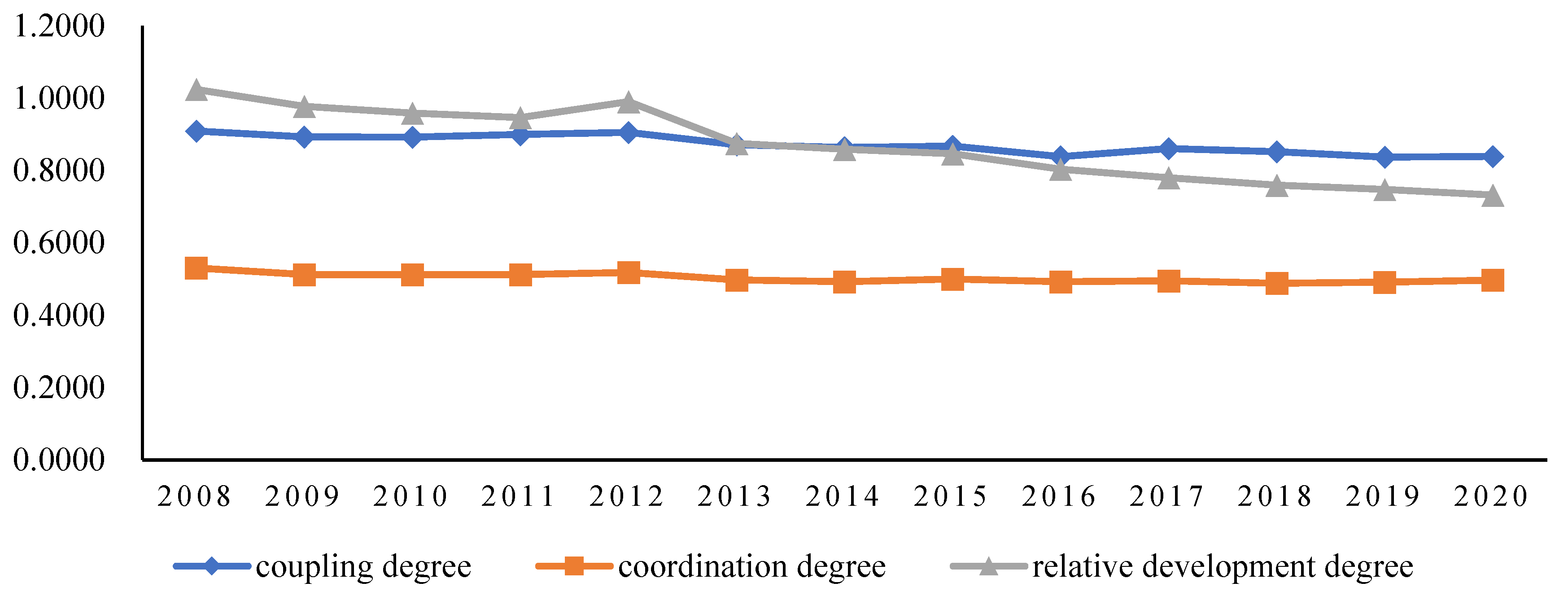
| Project | Classification Criteria | Stage or Type |
|---|---|---|
| Coupling degree | [0, 0.2] | Highly uncoupled |
| (0.2, 0.4] | Not coupled | |
| (0.4, 0.6] | Low degree of coupling | |
| (0.6, 0.8] | Moderate coupling | |
| (0.8, 1] | Highly coupled | |
| Coordination degree | [0, 0.3] | Severely dysfunctional recession |
| (0.3, 0.4] | Moderate dysregulation decline | |
| (0.4, 0.5] | Mild dysregulation decline | |
| (0.5, 0.6] | Reluctantly coordinated development | |
| (0.6, 0.7] | Primary coordinated development | |
| (0.7, 0.8] | Moderately coordinated development | |
| (0.8, 1] | Well coordinated development | |
| Relative development degree | [0, 0.8] | Cultivated land intensive use lag type |
| (0.8, 1.2] | Synchronous development type | |
| (1.2, θ) | The new-type urbanization lag type |
| Project | Classification Criteria | Stage or Type | Province | |
|---|---|---|---|---|
| Coupling degree | [0, 0.2] | Highly uncoupled | ||
| (0.2, 0.4] | Not coupled | |||
| (0.4, 0.6] | Low degree of coupling | Beijing (0.4798) | ||
| (0.6, 0.8] | Moderate coupling | Tianjin (0.7073), Shanxi (0.7213), Shaanxi (0.6814), Gansu (0.6456) | ||
| (0.8, 1] | Highly coupled | Hebei (0.9289), Inner Mongolia (0.9293), Liaoning (0.8077), Jilin (0.9692), Heilongjiang (0.9869), Shanghai (0.9968), Jiangsu (0.8654), Zhejiang (0.8980), Anhui (0.9638), Fujian (0.8506), Jiangxi (0.9638), Shandong (0.9076), Henan (0.9436), Hubei (0.9590), Hunan (0.9218), Guangdong (0.9216), Guangxi (0.8326), Hainan (0.9194), Chongqing (0.8752), Sichuan (0.9225), Guizhou (0.9320), Yunnan (0.9548), Qinghai (0.9512), Ningxia (0.8051), Xinjiang (0.8897) | ||
| Coordination degree | [0, 0.3] | Severely dysfunctional recession | ||
| (0.3, 0.4] | Moderate dysregulation decline | Shanxi (0.3836), Gansu (0.3332) | ||
| (0.4, 0.5] | Mild dysregulation decline | Beijing (0.4691), Tianjin (0.4906), Hebei (0.4980), Inner Mongolia (0.4524), Liaoning (0.4615), Jilin (0.4605), Heilongjiang (0.4967), Guangxi (0.4500), Chongqing (0.4741), Sichuan (0.4906), Guizhou (0.4225), Yunnan (0.4508), Shaanxi (0.4209), Qinghai (0.4703), Ningxia (0.4154) Xinjiang (0.4982) | ||
| (0.5, 0.6] | Reluctantly coordinated development | Anhui (0.5209), Fujian (0.5685), Jiangxi (0.5403), Shandong (0.5689), Henan (0.5331), Hubei (0.5204), Hunan (0.5299), Hainan (0.5094) | ||
| (0.6, 0.7] | Primary coordinated development | Jiangsu (0.6233), Zhejiang (0.6315), Guangdong (0.6496) | ||
| (0.7, 0.8] | Moderately coordinated development | Shanghai (0.7482) | ||
| (0.8, 1] | Well coordinated development | |||
| Relative Development degree | [0, 0.8] | Cultivated land intensive use lag type | Beijing (0.4618), Tianjin (0.5935), Shanxi (0.6059), Inner Mongolia (0.7993), Liaoning (0.6649), Jiangsu (0.7187), Zhejiang (0.7727), Shandong (0.7936), Chongqing (0.7600), Shaanxi (0.5736), Gansu (0.5572), Ningxia (0.6778), Xinjiang (0.7476) | |
| (0.8, 1.2] | Synchronous development type | Hebei (0.9454), Jilin (0.8670), Heilongjiang (0.9323), Shanghai (1.0066), Anhui (1.0123), Jiangxi (1.0522), Henan (1.0332), Hubei (0.9528), Hunan (1.1859), Guangdong (0.8176), Sichuan (0.8058), Guizhou (0.8492), Yunnan (0.9109), Qinghai (0.8582) | ||
| (1.2, θ) | The new-type urbanization lag type | Fujian (1.4146), Guangxi (1.4351), Hainan (1.2615) | ||
Publisher’s Note: MDPI stays neutral with regard to jurisdictional claims in published maps and institutional affiliations. |
© 2022 by the authors. Licensee MDPI, Basel, Switzerland. This article is an open access article distributed under the terms and conditions of the Creative Commons Attribution (CC BY) license (https://creativecommons.org/licenses/by/4.0/).
Share and Cite
Wang, Y.; Jin, C.; Peng, Q.; Liu, J.; Wu, X. Systematic Measurement and Evolution Situation of Coupling Coordination Level between Intensive Cultivated Land Utilization and New-Type Urbanization. Sustainability 2022, 14, 11716. https://doi.org/10.3390/su141811716
Wang Y, Jin C, Peng Q, Liu J, Wu X. Systematic Measurement and Evolution Situation of Coupling Coordination Level between Intensive Cultivated Land Utilization and New-Type Urbanization. Sustainability. 2022; 14(18):11716. https://doi.org/10.3390/su141811716
Chicago/Turabian StyleWang, Yafei, Chao Jin, Qingyun Peng, Jing Liu, and Xiaohang Wu. 2022. "Systematic Measurement and Evolution Situation of Coupling Coordination Level between Intensive Cultivated Land Utilization and New-Type Urbanization" Sustainability 14, no. 18: 11716. https://doi.org/10.3390/su141811716
APA StyleWang, Y., Jin, C., Peng, Q., Liu, J., & Wu, X. (2022). Systematic Measurement and Evolution Situation of Coupling Coordination Level between Intensive Cultivated Land Utilization and New-Type Urbanization. Sustainability, 14(18), 11716. https://doi.org/10.3390/su141811716






